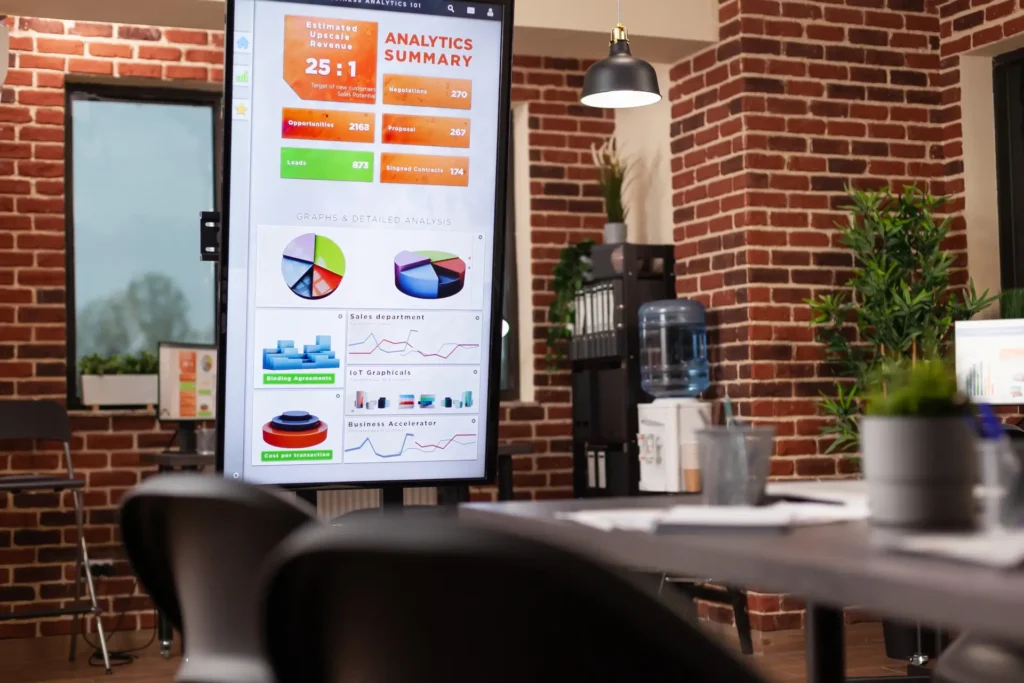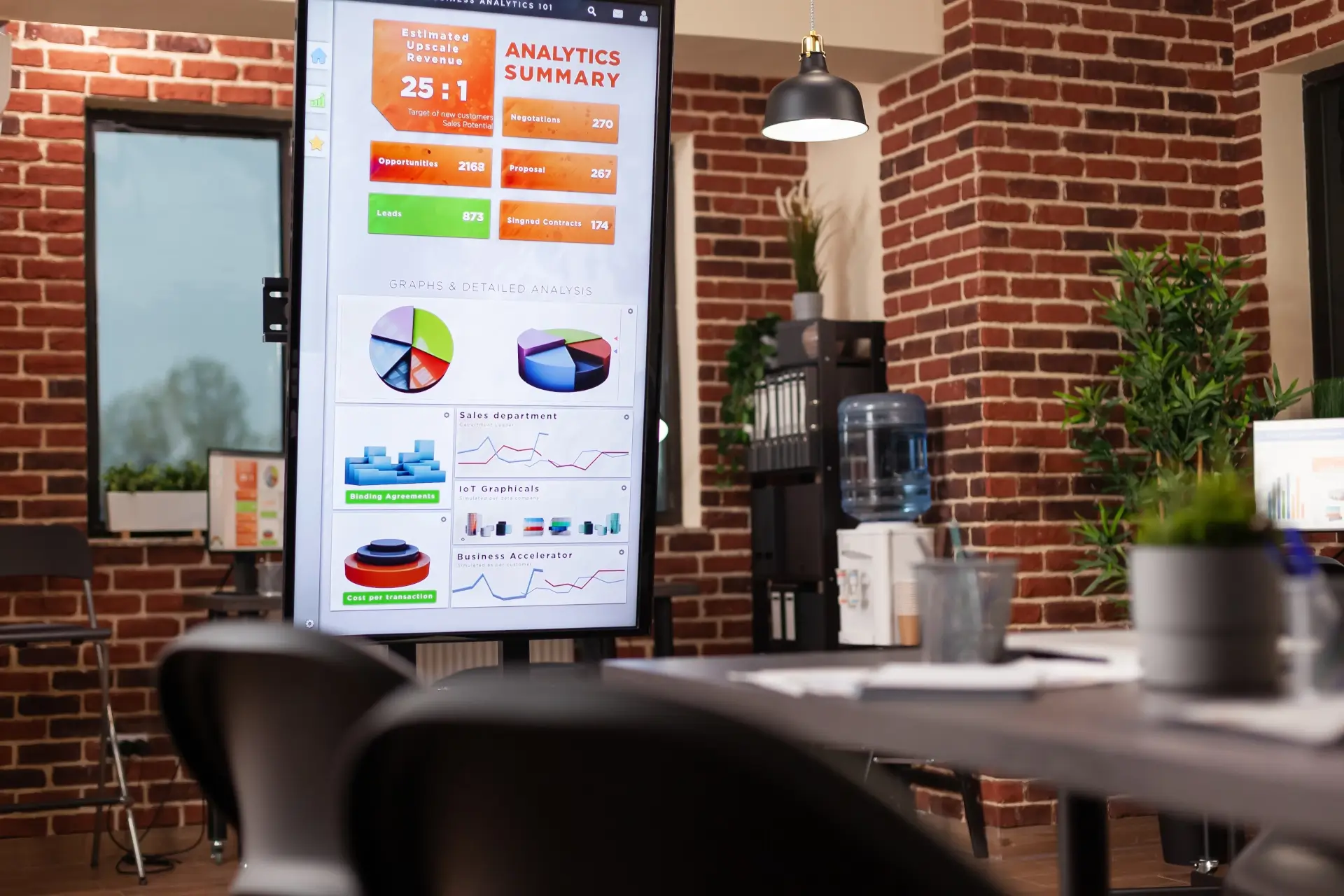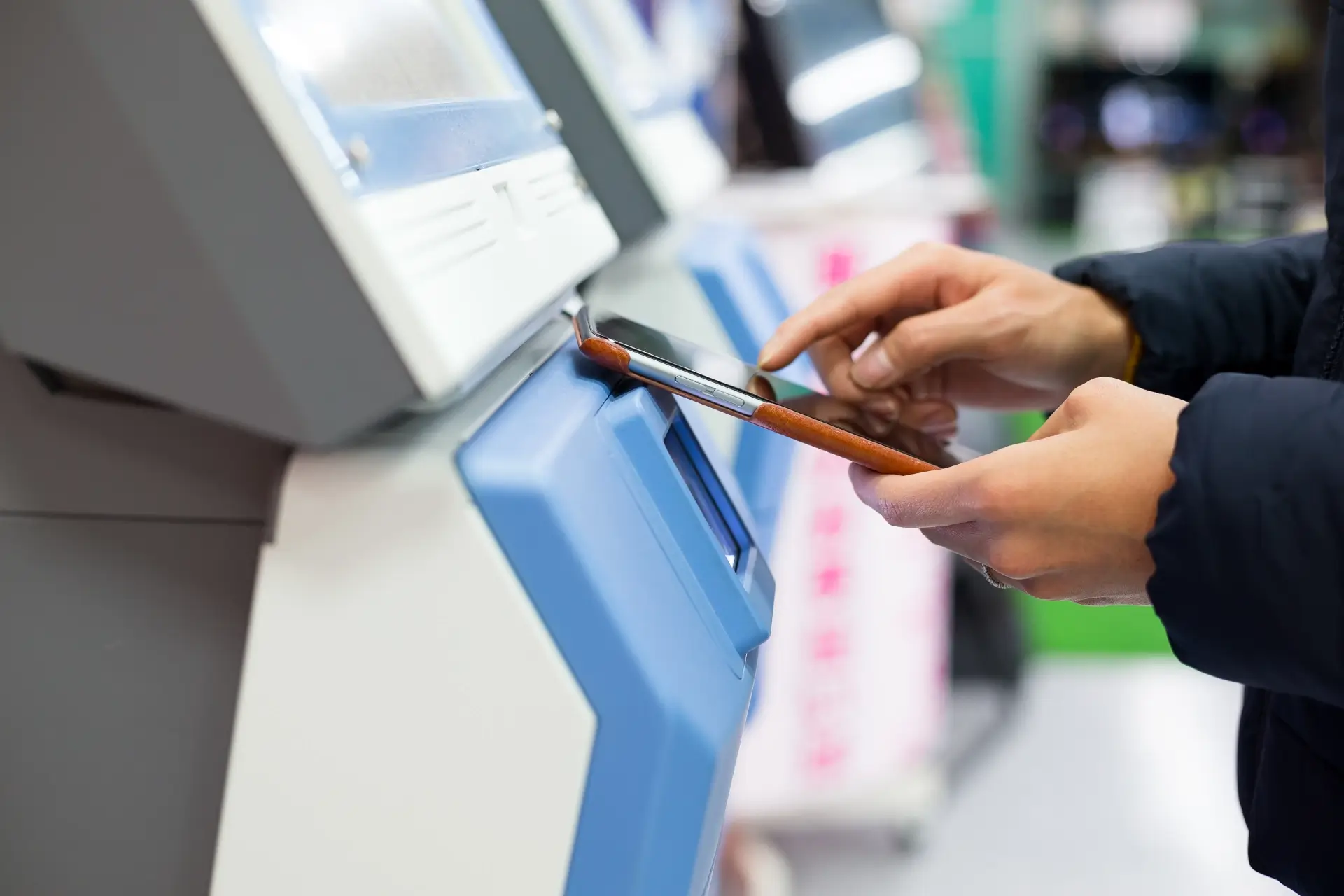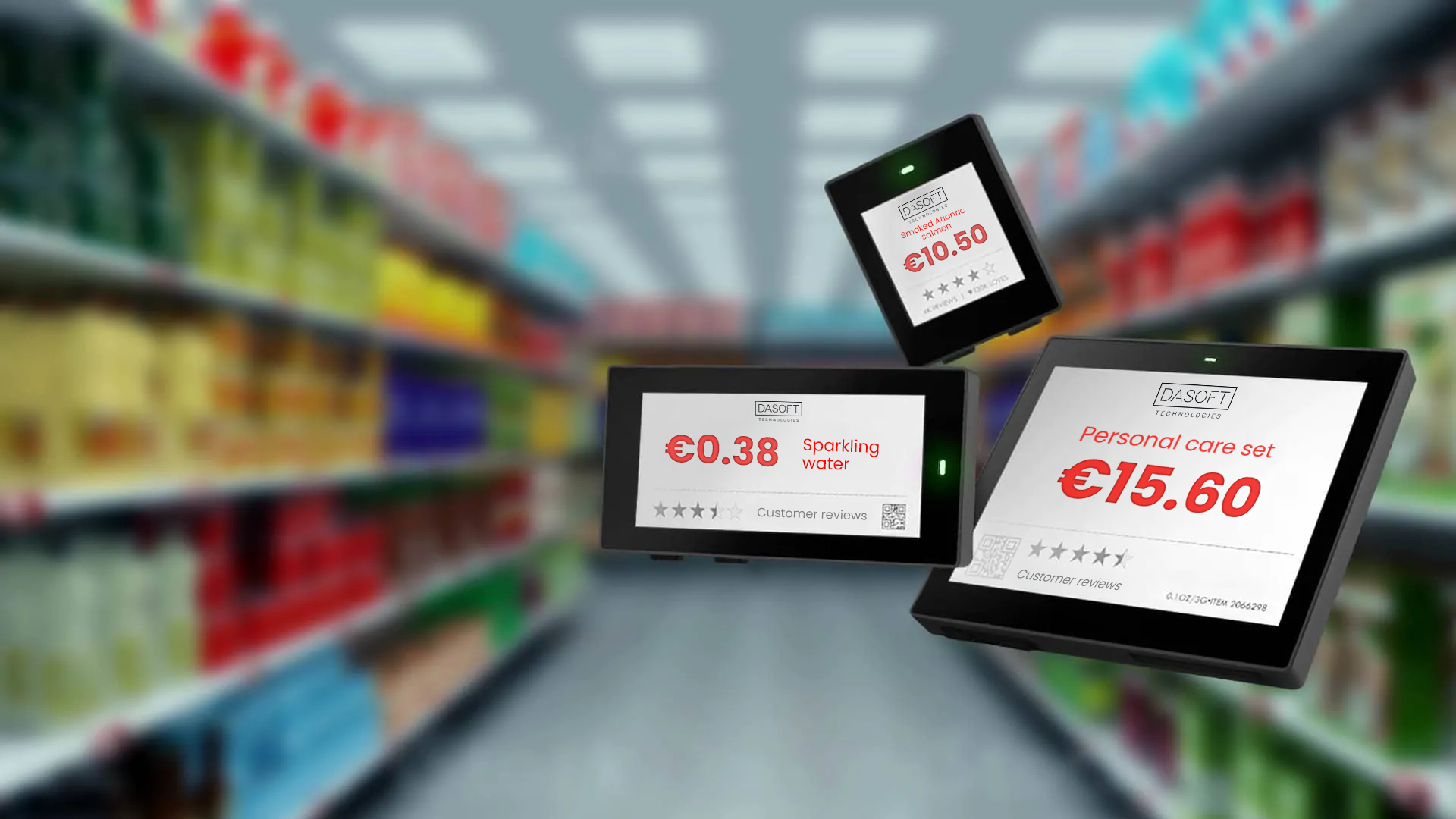Digital Signage is a modern form of visual communication that has transformed how businesses and institutions reach their audiences. Thanks to dynamic content displayed on digital screens, it enables fast, attractive and flexible delivery of information to both customers and employees. This technology is used across many industries: from retail to transportation, education and public administration. In this article we’ll explain in detail what Digital Signage is, how it works and what benefits it can bring to your organization.
Spis treści
- 1 What Is Digital Signage? Definition and Core Principles
- 2 What Does a Digital Signage System Consist Of? Key Components and Their Functions
- 3 How Does Digital Signage Work? Step-by-Step Operation in Practice
- 4 Types of Digital Signage Screens– Which One Is Right for Your Business?
- 5 In Which Industries Does Digital Signage Work Best? Example Applications
- 6 What Are the Benefits of Implementing Digital Signage in Your Business or Institution?
- 7 Digital Signage vs. Traditional Communication– Comparing Effectiveness
- 8 Digital Signage Software– What to Know Before You Choose
- 9 What to Consider When Implementing Digital Signage? Practical Tips
- 10 The Future of Digital Signage– Innovation and Trends in Visual Communication
What Is Digital Signage? Definition and Core Principles
Digital Signage is a system for displaying multimedia content on electronic screens to share information, advertisements and announcements in real time. Unlike traditional static advertising, Digital Signage allows dynamic content management– making it easy to update, personalize and tailor messaging to specific audiences.
The technology combines hardware (screens, media players) with management software (CMS) to enable centralized control of information or promotional campaigns across multiple locations at once. Digital Signage screens can display videos, graphics, animations, text messages, weather data, queue system information or even social media integrations.
The goal of Digital Signage isn’t just to catch the viewer’s eye but also to improve communication effectiveness, increase engagement and make information management easier in both public and commercial spaces. It’s a tool that merges technology with marketing to support modern communication strategies in all kinds of organizations.

What Does a Digital Signage System Consist Of? Key Components and Their Functions
A Digital Signage system is an integrated solution combining hardware and software to deliver effective management and display of digital content. While it may seem simple to the end user, it actually consists of multiple interconnected components, each playing a crucial role.
- Digital Screens (Displays): The most visible part of the system– these can be LCD monitors, LED panels, advertising totems or video walls. The choice depends on the location, intended use and environmental conditions (indoor or outdoor).
- Media Players: Small devices or mini-PCs that receive content from the server and play it on the screen. Sometimes they’re integrated into the display itself.
- CMS (Content Management System): The heart of the system– a platform for creating, managing and scheduling content. Users can remotely upload graphics, videos, text messages or external data to be displayed.
- Network (LAN, Wi-Fi, LTE): Communication between the CMS and media players happens over a local or internet connection, enabling management of geographically dispersed screens from a single admin panel.
- Power and Mounting Systems: The technical infrastructure includes mounts, enclosures, cooling systems and anti-theft protections for safe and durable installation of screens.
When all these elements work together, Digital Signage delivers reliable, flexible and real-time visual communication.
How Does Digital Signage Work? Step-by-Step Operation in Practice
A Digital Signage system relies on a carefully designed information flow to display dynamic content in real time, locally or across multiple locations at once. While it looks intuitive and automatic to viewers, there’s a complex mechanism behind the scenes. Here’s how it works:
Step 1: Content Creation. The process starts with preparing materials for display– graphics, animations, videos, text messages, weather info, external data or ads. These may be created by designers, marketers or automatically generated by analytics systems.
Step 2: Content Management in CMS. Finished materials are uploaded to the CMS, which organizes them, assigns them to specific screens and sets the display schedule. The operator decides what content shows at what time, on which day and in which location.
Step 3: Data Transmission to Media Players. Once the campaign is planned, the CMS sends data to the media players at each screen. Communication happens over LAN, Wi-Fi or LTE.
Step 4: Display on Screens. Media players process the data and deliver it to the Digital Signage screens. The content can be static or dynamic, interactive, synchronized with other screens or completely independent.
Step 5: Monitoring and Updates. The system allows real-time monitoring of playback. If any screen stops working, the admin is alerted. Content can also be updated instantly in response to needs like promoting a product, changing opening hours or delivering emergency alerts.
This flexibility, automation and remote control make Digital Signage such a powerful communication tool in retail spaces and public venues alike.
Types of Digital Signage Screens– Which One Is Right for Your Business?
Choosing the right type of screen is crucial for an effective Digital Signage setup. The market offers many options that differ not just in size, image quality and weather resistance but also in features tailored to specific use cases. Your choice should depend on location, message type and audience needs.
LCD Monitors are the most common choice for indoor environments like shops, malls, hotels or offices. They offer high image quality at a reasonable price and work well for advertising, menus, product information or event announcements.
LED Screens are built for large-scale or outdoor applications where visibility from a distance is essential, such as building facades, city spaces, stadiums or shopping center exteriors. They’re very bright, weather-resistant and can be built in modular configurations of any size.
Touch Screens allow interactive engagement and are used in info kiosks, self-service points or queue systems. Customers can browse services, take a queue number or get directions. Multimedia Totems are vertical, free-standing units perfect for high-traffic areas like airports, train stations or shopping arcades. Their modern design attracts attention and enhances the perceived quality of the space.
Video Walls consist of multiple screens joined to form a single large surface, creating impressive displays for galleries, conference rooms or control centers.
When choosing a Digital Signage screen, consider not only the location and desired image quality but also the equipment’s durability, integration options and aesthetic fit with its surroundings. The right screen is the foundation for effective, reliable operation.
In Which Industries Does Digital Signage Work Best? Example Applications
Digital Signage is gaining ground in more industries because it enables effective, flexible and visually appealing communication. Its versatility allows it to serve marketing, informational or organizational purposes tailored to specific sectors. Here are some common applications:
Retail. In stores and malls Digital Signage displays promotions, new products, video ads or dynamic price labels. It boosts customer engagement and drives real-time buying decisions. Integration with POS systems allows content to adapt automatically based on time, location or sales data.
Food Service. In restaurants, quick-service venues and cafes Digital Signage acts as a digital menu board, making it easy to update offerings and prices quickly and accurately. Screens show appetizing images that help customers choose.
Public Transport and Logistics. At airports, train stations and bus stops Digital Signage displays schedules, delays, gate numbers or routes. In warehouses and logistics centers it supports internal communication and operational coordination.
Education. In schools, universities and training centers screens show class schedules, announcements, event timetables or learning materials. They can also serve as emergency alert systems.
Healthcare. In medical facilities Digital Signage improves patient experience by displaying queue numbers, available doctors, registration rules or health education messages, reducing stress and easing staff workload.
Public Administration. Government offices use Digital Signage to communicate with citizens, showing service info, opening hours, queue numbers and procedural steps. It improves wayfinding and speeds up service.
Corporate. In offices and company headquarters Digital Signage supports internal communication with employees by displaying goals, results or HR information. It can also welcome guests in reception areas in a modern way.
Of course these are just examples. Digital Signage is flexible enough to fit almost any environment where clear, fast communication is important.
What Are the Benefits of Implementing Digital Signage in Your Business or Institution?
Investing in Digital Signage isn’t just about adopting a trendy technology. It’s a real step toward more effective communication, better information management and improved service. No matter the sector, digital screens offer many measurable and intangible benefits that impact branding, sales results and operational organization.
- Better Attention Capture. Dynamic videos, animations and interactive presentations grab attention far more effectively than static posters or banners. Messages reach more people and are remembered longer.
- Fast Content Updates. From a single admin panel you can change content on dozens of screens in seconds, regardless of their location. This saves time and cuts costs associated with printing and distributing traditional materials.
- Greater Communication Flexibility. Digital Signage lets you adapt content to time of day, location, target audience or even weather and traffic conditions, ensuring the message is always relevant.
- Increased Sales and Customer Engagement. In retail and food service Digital Signage encourages impulse purchases with attractive product presentations, promotions or personalized offers. Interactive screens further engage customers and invite them to act.
- Professional Brand Image. Modern screens in your space show you care about quality communication and innovation. Customers and business partners see you as modern and well-organized.
- Easier Internal Communication and Team Management. In offices, factories or public institutions Digital Signage quickly shares information with staff about results, events, safety procedures or organizational changes.
- Error and Chaos Reduction. Centralized content management eliminates outdated information, errors in hanging posters and inconsistent messaging. Everything is synchronized and organized.
Digital Signage isn’t just a trend– it’s a practical tool that improves marketing, communication and operational efficiency. Its scalability and versatility mean it can fit the needs of both small businesses and large institutions.
Digital Signage vs. Traditional Communication– Comparing Effectiveness
When you compare Digital Signage to traditional communication forms like posters, flyers, banners or info boards, the differences are obvious not just in aesthetics but in effectiveness and flexibility.
Digital systems let you instantly update content without the costs of printing or physical replacements. In a world where information quickly goes out of date this real-time responsiveness is a key advantage.
Digital Signage also delivers dynamic, multimedia messages that engage audiences much more effectively than static images. Motion, changing content, visual effects and interactivity draw the eye and boost message retention. Traditional methods are passive and inflexible– they offer a single, unchanging message that quickly loses impact.
Digital Signage also allows precise targeting based on location, audience or even time of day.
Messaging can vary between stores, floors of a building or specific times– something static materials simply can’t match. Plus digital systems let you gather data, analyze campaign effectiveness and make quick adjustments for better results.
It’s also more sustainable– reducing paper and printing waste makes Digital Signage a greener, more responsible choice. Over time this cuts operating costs and builds your brand’s reputation as modern and environmentally conscious.
While traditional media still have their place in some contexts, more organizations are moving to digital solutions for their flexibility, impact and control over messaging. Digital Signage doesn’t just replace old methods– it outperforms them in functionality and results.

Digital Signage Software– What to Know Before You Choose
At the heart of any Digital Signage system is the content management software, or CMS. This is what lets you create, schedule and distribute materials to screens, regardless of number or location.
Choosing the right software is essential for system performance and ease of use, so it’s worth understanding its capabilities before you decide.
Modern CMS platforms offer intuitive admin panels for adding graphics, videos, text, presentations or content from external sources like social media, weather feeds, RSS or queue systems. You can schedule when and where these materials appear, tailoring content precisely to time of day, day of the week or audience profile.
Many CMS solutions are cloud-based, so you can manage them from anywhere with an internet connection. This is particularly useful for organizations with multiple locations wanting consistent yet locally relevant messaging. Look for features like user permissions, automatic technical alerts, playback stats and integrations with other IT systems.
For advanced needs some platforms also support interactive content – forms, quizzes or touch-screen interfaces reacting to user behavior. Others let you plan advertising campaigns by screen group and analyze their performance in real time.
When choosing a CMS consider not just its features but ease of use, technical support and the ability to expand the system in the future. The right software ensures smooth operation, full control over messaging and saves time in day-to-day management.
What to Consider When Implementing Digital Signage? Practical Tips
Rolling out a Digital Signage system is more than just buying screens and software– it’s a complex process that needs careful planning, covering technical, organizational and communication aspects.
Done right, it delivers real improvements and measurable benefits. Done poorly, it risks wasting the technology’s potential.
The first step is to clearly define your goals. A system for in-store advertising will look very different from one in a government office sharing information with visitors. Think about what you want to communicate, to whom, where and how often. Setting these parameters early helps avoid unnecessary costs and ensures the right technical choices.
Location is also critical. Screen placement affects visibility, power and network access, and security.
Screens should be installed where viewers can easily see and absorb the content– entrances, waiting areas, checkout lines or info points. Consider environmental factors like lighting, temperature and noise.
Choosing the right hardware and software is equally important. Invest in reputable, scalable solutions you can expand with more screens or features in future. The software should be intuitive, support remote management and offer reliable technical assistance.
Content is key too. Even the best system fails without engaging, brand-consistent, clear and audience-appropriate materials. Regular updates are essential to keep screens from going “dead.”
Finally, don’t forget staff training and emergency procedures. Your team needs to know how to use the system day-to-day so it runs smoothly without external help.
A well-planned Digital Signage deployment is an investment that pays off over time– improving communication, enhancing customer experiences and supporting your business goals.
The Future of Digital Signage– Innovation and Trends in Visual Communication
Digital Signage is not only growing rapidly but also adapting to changing audience expectations and communication trends. Where the main goal once was simply replacing printed materials with screens, today’s systems are increasingly intelligent, interactive and integrated with other technologies– opening up entirely new possibilities.
One of the biggest trends is personalization. More companies are using external data– location, time of day, demographics or even customer behavior analysis– to tailor content to individual viewers.
Integrated with CRM, POS or AI, Digital Signage can deliver dynamic, real-time messaging matched to the moment and place.
Interactivity is also expanding. Touch screens, motion sensors, gesture and voice recognition make viewers active participants rather than passive observers. In retail and services this means customers can browse products, place orders or even pay without staff help.
AI-powered solutions are becoming more important too. Algorithms can analyze viewer data and context to automatically optimize content for better engagement and conversions. With cameras or beacons you can even tailor messaging based on age or gender of the viewer.
Screen technology itself is evolving– thinner, brighter, more energy-efficient and flexible displays allow for more creative installations that blend seamlessly into architecture. High-resolution LED walls are now standard not just outdoors but in premium indoor spaces.
Sustainability also matters. Modern Digital Signage systems are designed for energy efficiency, longer component life and less waste– important for responsible businesses.
Looking ahead we’ll see deeper integration with augmented reality (AR), the Internet of Things (IoT) and mobile technologies. All of this makes visual communication more advanced, flexible and indispensable for modern organizations– ready to meet the challenges of the future and the expectations of digital societies.



